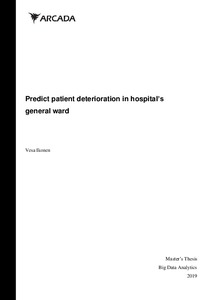Predict patient deterioration in hospital's general ward
Ikonen, Vesa (2020)
Ikonen, Vesa
2020
All rights reserved. This publication is copyrighted. You may download, display and print it for Your own personal use. Commercial use is prohibited.
Julkaisun pysyvä osoite on
https://urn.fi/URN:NBN:fi:amk-202003083127
https://urn.fi/URN:NBN:fi:amk-202003083127
Tiivistelmä
Increasing amount of patient monitoring data is available in hospitals in an electronic format. Patient data is mostly available from hospital departments which provide intensive treatment, but wireless and wearable sensors will enable constant monitoring of vital sign parameters also in hospitals general ward. High-frequency real-time patient data enables development of systems which automatically notify clinicians if patient condition deteriorates. The situation can be even further improved by developing data analytics tools which are able to predict changes in patient condition.
The aim of this study is to develop machine learning tools for predicting patient deterioration in hospital’s general ward which supports continuous monitoring of vital sign parameters. The novel idea of the study is to simulate general ward data by selecting a subset of the intensive care unit data. Patient deterioration is defined by National Early Warning Score (NEWS) threshold of 7. The task is to predict if patient deteriorates within 2 hours prediction window using a gap of one hour between the prediction time and prediction window. Patient’s medical information from the past one hour is utilized in the prediction. Four supervised machine learning models are trained for the classification; logistic regression, kernelized support vector machine, random forest and gradient boosting classifier. The best model is searched using a grid search with 10-fold cross-validation in the development set.
Gradient boosting classifier achieves the best cross-validation performance; AUROC of 0,813 and AUPRC of 0,375. In the test set evaluation, model’s AUROC is 0,808 and AUPRC is 0,348. Test set prevalence is 10,8%. Using the model’s default threshold, test set sensitivity is 0,744 and precision is 0,240. It means that the model correctly detects 3 out of 4 deteriorations. Among all the predicted deteriorations, the proportion of correct predictions is 1 in 4.
Gradient boosting classifier’s test set performance is compared to NEWS scoring system’s medium level clinical alert which works as a baseline. Using model’s threshold which provides the same sensitivity as baseline, gradient boosting classifier has 25% less false positives. Using model’s threshold which provides the same precision as baseline, gradient boosting classifier has 45 % higher sensitivity than the baseline.
The achieved results suggest that real-time prediction of patient deterioration based on the NEWS could assist clinicians in identifying deteriorating patients in hospitals general ward. NEWS is widely used in hospitals general ward and providing NEWS prediction in addition to real-time NEWS could help clinical staff in focusing in most critical patients. The achieved precision remains moderate in the study and could be a topic for the future research.
The aim of this study is to develop machine learning tools for predicting patient deterioration in hospital’s general ward which supports continuous monitoring of vital sign parameters. The novel idea of the study is to simulate general ward data by selecting a subset of the intensive care unit data. Patient deterioration is defined by National Early Warning Score (NEWS) threshold of 7. The task is to predict if patient deteriorates within 2 hours prediction window using a gap of one hour between the prediction time and prediction window. Patient’s medical information from the past one hour is utilized in the prediction. Four supervised machine learning models are trained for the classification; logistic regression, kernelized support vector machine, random forest and gradient boosting classifier. The best model is searched using a grid search with 10-fold cross-validation in the development set.
Gradient boosting classifier achieves the best cross-validation performance; AUROC of 0,813 and AUPRC of 0,375. In the test set evaluation, model’s AUROC is 0,808 and AUPRC is 0,348. Test set prevalence is 10,8%. Using the model’s default threshold, test set sensitivity is 0,744 and precision is 0,240. It means that the model correctly detects 3 out of 4 deteriorations. Among all the predicted deteriorations, the proportion of correct predictions is 1 in 4.
Gradient boosting classifier’s test set performance is compared to NEWS scoring system’s medium level clinical alert which works as a baseline. Using model’s threshold which provides the same sensitivity as baseline, gradient boosting classifier has 25% less false positives. Using model’s threshold which provides the same precision as baseline, gradient boosting classifier has 45 % higher sensitivity than the baseline.
The achieved results suggest that real-time prediction of patient deterioration based on the NEWS could assist clinicians in identifying deteriorating patients in hospitals general ward. NEWS is widely used in hospitals general ward and providing NEWS prediction in addition to real-time NEWS could help clinical staff in focusing in most critical patients. The achieved precision remains moderate in the study and could be a topic for the future research.
